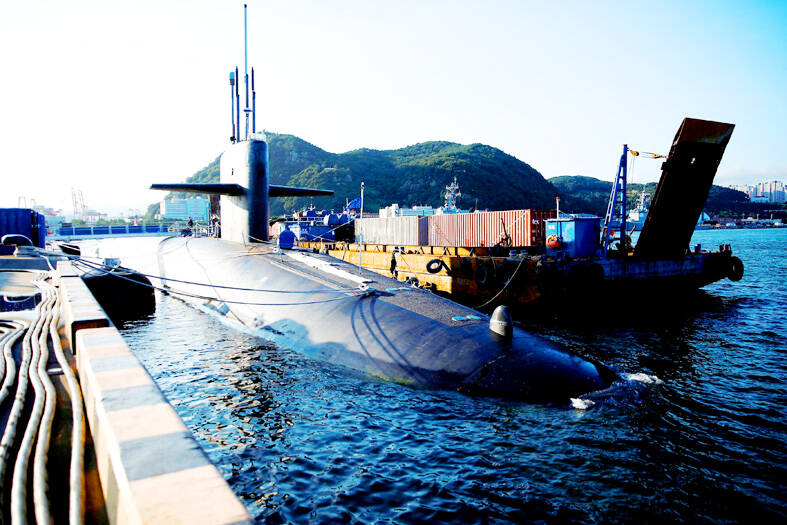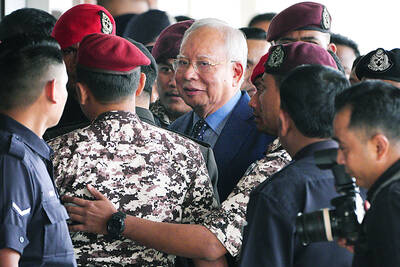When a US ballistic missile submarine (SSBN) surfaced for a rare visit to South Korea this week, it was a blunt reminder that Washington always has nuclear-tipped missiles deployed within close striking distance of North Korea, analysts said.
Having nuclear weapons out of sight in the seas off the Korean Peninsula was a potentially stronger deterrent to the North, some analysts said, than installing them in South Korea, as Washington had done from 1958 to 1991.
“Placing nuclear weapons offshore and on submarines is actually a stronger deterrent in many ways,” Duyeon Kim of the Center for a New American Security said. “Deterrence is strengthened when the location of American strategic assets is unknown to the adversary as long as the adversary knows that these weapons exist.”

Photo: Reuters
The USS Kentucky Ohio-class SSBN arrived in South Korea’s southern port of Busan on Tuesday and wrapped up its visit yesterday, a source with direct knowledge of its movements said.
It got North Korea’s attention.
On Thursday, North Korea’s minister of defense said the mere presence of such weapons in South Korea could meet the criteria for the Pyongyang to use its nuclear weapons, and warned the US against sending any more nuclear-capable assets.
The Kentucky’s visit was the first by an SSBN to South Korea since the 1980s, and it follows an increasing debate in recent years over whether the US should return tactical nuclear weapons to South Korea, or whether it should develop its own.
Giving reassurance of its commitment to defend the South, Washington has responded by stepping up displays of nuclear force and create a new group for war planning.
China, the North’s most important ally, has not commented on the submarine’s visit, but it has accused the US of increasing tension in the region with its military deployments.
Because US SSBNs rely on secrecy and stealth to ensure their survival and preserve their ability to launch nuclear missiles during a war, they rarely make public stops in foreign ports.
SSBNs are the most survivable delivery platform of all US nuclear weapons, essentially guaranteeing overwhelming nuclear retaliation in the event of an enemy first strike, said Vann Van Diepen, a former US government weapons expert who works with the 38 North project that monitors North Korea.
The US Navy fields 14 SSBNs, often referred to as “boomers.” An Ohio-class submarine carries 20 Trident II D5 missiles, each of which can deliver up to eight nuclear warheads to targets as far as 12,000km away.
“US SSBNs anywhere from the US West coast westward can strike targets in North Korea,” Van Diepen said. “Therefore, some US SSBNs are within range of North Korea at all times.”
North Korea has a large, but aging submarine force with a primary mission to defend its coastline, but is looking to develop its own arsenal of missile submarines.
It has conducted launches from a test submarine, and has been seeking to build an operational conventionally powered missile submarine since at least 2016, Van Diepen said.
However, the North is many years away from developing the technical capability to build a nuclear-powered submarine that would give it unlimited range, he said.
For now, a missile submarine would only marginally supplement the North’s burgeoning land-based nuclear force, he said.
“De facto nuclear sharing between the United States and South Korea is happening,” said Choi Il, a retired South Korean submarine captain.
“Kentucky’s port call in Busan is telling us that the submarine has already been operating in waters around the Korean Peninsula and even after it leaves Busan, the US nuclear asset is always deployed in waters nearby,” he said.

Shamans in Peru on Monday gathered for an annual New Year’s ritual where they made predictions for the year to come, including illness for US President Donald Trump and the downfall of Venezuelan President Nicolas Maduro. “The United States should prepare itself because Donald Trump will fall seriously ill,” Juan de Dios Garcia proclaimed as he gathered with other shamans on a beach in southern Lima, dressed in traditional Andean ponchos and headdresses, and sprinkling flowers on the sand. The shamans carried large posters of world leaders, over which they crossed swords and burned incense, some of which they stomped on. In this

The death of a former head of China’s one-child policy has been met not by tributes, but by castigation of the abandoned policy on social media this week. State media praised Peng Peiyun (彭珮雲), former head of China’s National Family Planning Commission from 1988 to 1998, as “an outstanding leader” in her work related to women and children. The reaction on Chinese social media to Peng’s death in Beijing on Sunday, just shy of her 96th birthday, was less positive. “Those children who were lost, naked, are waiting for you over there” in the afterlife, one person posted on China’s Sina Weibo platform. China’s

‘NO COUNTRY BUMPKIN’: The judge rejected arguments that former prime minister Najib Razak was an unwitting victim, saying Najib took steps to protect his position Imprisoned former Malaysian prime minister Najib Razak was yesterday convicted, following a corruption trial tied to multibillion-dollar looting of the 1Malaysia Development Berhad (1MDB) state investment fund. The nation’s high court found Najib, 72, guilty on four counts of abuse of power and 21 charges of money laundering related to more than US$700 million channeled into his personal bank accounts from the 1MDB fund. Najib denied any wrongdoing, and maintained the funds were a political donation from Saudi Arabia and that he had been misled by rogue financiers led by businessman Low Taek Jho. Low, thought to be the scandal’s mastermind, remains

Australian Prime Minister Anthony Albanese yesterday announced plans for a national bravery award to recognize civilians and first responders who confronted “the worst of evil” during an anti-Semitic terror attack that left 15 dead and has cast a heavy shadow over the nation’s holiday season. Albanese said he plans to establish a special honors system for those who placed themselves in harm’s way to help during the attack on a beachside Hanukkah celebration, like Ahmed al-Ahmed, a Syrian-Australian Muslim who disarmed one of the assailants before being wounded himself. Sajid Akram, who was killed by police during the Dec. 14 attack, and